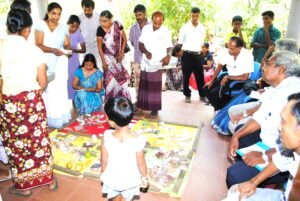CATEGORY
ongoing Projects

DETAILS
The Revalorisation of Small Millets in South Asia (RESMISA) project was initiated in 2013, focusing on the
Tanamalwila and Wellawaya areas of the Arthacharya network with funding from the International
Development Research Centre (IDRC) and Canadian International Development Agency (CIDA) in
Canada.
The main objective of the project was to increase food security and food availability in poor families in
marginal areas of the dry zone where the small farmers are mostly dependent on rainfed agriculture.
According to GLORDC in Angunakolapelessa, 83 per cent of the farmers are all but marginal farmers who
have no access to any major or minor irrigation. They are totally dependent on the seasonal monsoon
rains, which are often erratic and unreliable. The vagaries of rainfall in this relatively arid area often
challenge the family's food security and food availability, thus subjecting the poor to high levels of
stunting and wasting malnutrition among children. Besides, malnutrition has severely affected pregnant
and lactating mothers as well as the old and feeble. It is well known that despite the impressive social
indicators Sri Lanka has recorded during the last few decades, its record profile on malnutrition has been
poor across the country.

Against this backdrop, Resmisa’s specific objective was to revalorize small millet cultivation that both
the authorities and the farmers had neglected due to various reasons. Various historical records of Sri
Lanka have established that small millets played an almost equal role in the diet of the people in the
period prior to colonization. The lack of attention paid by the authorities caused the dwindling of the
small millet cultivations from 95,000 ha in 1948 to 5,000 ha at the time of project initiation. The
aridness-resilient crop guaranteed food availability and food security during harsh times in the dry zone
of Sri Lanka. The policy shift the authorities made for cash crops and paddy giving them the highest
priority brought imbalance to the family food supply and security.
Arthacharya, through the project, tried to build a replicable model to resuscitate small millet through a
series of interventions right along the value chain. While identifying the more productive indigenous
varieties through the partnership it officially had with the Department of Agriculture, the project also
provided space for the breeding of new varieties. The project also tried to introduce new technology to
improve processing while it had educational programmes to popularize it among school children and
housewives. Arthacharya’s sister organisation, AIL, provided credit for the farmers who required capital
to expand their small millet cultivations.
The donors, IDRC and CIDA, had given the project an international dimension when they promoted the
same programme, especially in South India, Bangladesh and Nepal. A key component of the project was
the platform created for the participating country programmes to interact with one another through
exposure visits, conferences and research action. The donors also involved seven Canadian universities,
while similar institutions were mobilised locally by the participating NGOs in the four countries.





